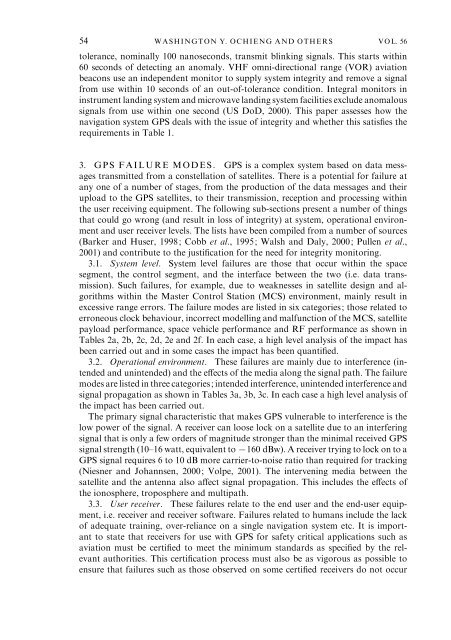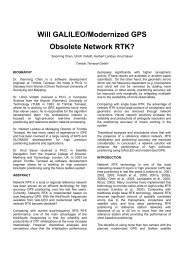GPS Integrity and Potential Impact on Aviation Safety - intelligent ...
GPS Integrity and Potential Impact on Aviation Safety - intelligent ...
GPS Integrity and Potential Impact on Aviation Safety - intelligent ...
You also want an ePaper? Increase the reach of your titles
YUMPU automatically turns print PDFs into web optimized ePapers that Google loves.
54 WASHINGTON Y. OCHIENG AND OTHERS VOL. 56<br />
tolerance, nominally 100 nanosec<strong>on</strong>ds, transmit blinking signals. This starts within<br />
60 sec<strong>on</strong>ds of detecting an anomaly. VHF omni-directi<strong>on</strong>al range (VOR) aviati<strong>on</strong><br />
beac<strong>on</strong>s use an independent m<strong>on</strong>itor to supply system integrity <str<strong>on</strong>g>and</str<strong>on</strong>g> remove a signal<br />
from use within 10 sec<strong>on</strong>ds of an out-of-tolerance c<strong>on</strong>diti<strong>on</strong>. Integral m<strong>on</strong>itors in<br />
instrument l<str<strong>on</strong>g>and</str<strong>on</strong>g>ing system <str<strong>on</strong>g>and</str<strong>on</strong>g> microwave l<str<strong>on</strong>g>and</str<strong>on</strong>g>ing system facilities exclude anomalous<br />
signals from use within <strong>on</strong>e sec<strong>on</strong>d (US DoD, 2000). This paper assesses how the<br />
navigati<strong>on</strong> system <str<strong>on</strong>g>GPS</str<strong>on</strong>g> deals with the issue of integrity <str<strong>on</strong>g>and</str<strong>on</strong>g> whether this satisfies the<br />
requirements in Table 1.<br />
3. <str<strong>on</strong>g>GPS</str<strong>on</strong>g> F AILURE M ODES. <str<strong>on</strong>g>GPS</str<strong>on</strong>g> is a complex system based <strong>on</strong> data messages<br />
transmitted from a c<strong>on</strong>stellati<strong>on</strong> of satellites. There is a potential for failure at<br />
any <strong>on</strong>e of a number of stages, from the producti<strong>on</strong> of the data messages <str<strong>on</strong>g>and</str<strong>on</strong>g> their<br />
upload to the <str<strong>on</strong>g>GPS</str<strong>on</strong>g> satellites, to their transmissi<strong>on</strong>, recepti<strong>on</strong> <str<strong>on</strong>g>and</str<strong>on</strong>g> processing within<br />
the user receiving equipment. The following sub-secti<strong>on</strong>s present a number of things<br />
that could go wr<strong>on</strong>g (<str<strong>on</strong>g>and</str<strong>on</strong>g> result in loss of integrity) at system, operati<strong>on</strong>al envir<strong>on</strong>ment<br />
<str<strong>on</strong>g>and</str<strong>on</strong>g> user receiver levels. The lists have been compiled from a number of sources<br />
(Barker <str<strong>on</strong>g>and</str<strong>on</strong>g> Huser, 1998; Cobb et al., 1995; Walsh <str<strong>on</strong>g>and</str<strong>on</strong>g> Daly, 2000; Pullen et al.,<br />
2001) <str<strong>on</strong>g>and</str<strong>on</strong>g> c<strong>on</strong>tribute to the justificati<strong>on</strong> for the need for integrity m<strong>on</strong>itoring.<br />
3.1. System level. System level failures are those that occur within the space<br />
segment, the c<strong>on</strong>trol segment, <str<strong>on</strong>g>and</str<strong>on</strong>g> the interface between the two (i.e. data transmissi<strong>on</strong>).<br />
Such failures, for example, due to weaknesses in satellite design <str<strong>on</strong>g>and</str<strong>on</strong>g> algorithms<br />
within the Master C<strong>on</strong>trol Stati<strong>on</strong> (MCS) envir<strong>on</strong>ment, mainly result in<br />
excessive range errors. The failure modes are listed in six categories; those related to<br />
err<strong>on</strong>eous clock behaviour, incorrect modelling <str<strong>on</strong>g>and</str<strong>on</strong>g> malfuncti<strong>on</strong> of the MCS, satellite<br />
payload performance, space vehicle performance <str<strong>on</strong>g>and</str<strong>on</strong>g> RF performance as shown in<br />
Tables 2a, 2b, 2c, 2d, 2e <str<strong>on</strong>g>and</str<strong>on</strong>g> 2f. In each case, a high level analysis of the impact has<br />
been carried out <str<strong>on</strong>g>and</str<strong>on</strong>g> in some cases the impact has been quantified.<br />
3.2. Operati<strong>on</strong>al envir<strong>on</strong>ment. These failures are mainly due to interference (intended<br />
<str<strong>on</strong>g>and</str<strong>on</strong>g> unintended) <str<strong>on</strong>g>and</str<strong>on</strong>g> the effects of the media al<strong>on</strong>g the signal path. The failure<br />
modes are listed in three categories; intended interference, unintended interference <str<strong>on</strong>g>and</str<strong>on</strong>g><br />
signal propagati<strong>on</strong> as shown in Tables 3a, 3b, 3c. In each case a high level analysis of<br />
the impact has been carried out.<br />
The primary signal characteristic that makes <str<strong>on</strong>g>GPS</str<strong>on</strong>g> vulnerable to interference is the<br />
low power of the signal. A receiver can loose lock <strong>on</strong> a satellite due to an interfering<br />
signal that is <strong>on</strong>ly a few orders of magnitude str<strong>on</strong>ger than the minimal received <str<strong>on</strong>g>GPS</str<strong>on</strong>g><br />
signal strength (10–16 watt, equivalent to x160 dBw). A receiver trying to lock <strong>on</strong> to a<br />
<str<strong>on</strong>g>GPS</str<strong>on</strong>g> signal requires 6 to 10 dB more carrier-to-noise ratio than required for tracking<br />
(Niesner <str<strong>on</strong>g>and</str<strong>on</strong>g> Johannsen, 2000; Volpe, 2001). The intervening media between the<br />
satellite <str<strong>on</strong>g>and</str<strong>on</strong>g> the antenna also affect signal propagati<strong>on</strong>. This includes the effects of<br />
the i<strong>on</strong>osphere, troposphere <str<strong>on</strong>g>and</str<strong>on</strong>g> multipath.<br />
3.3. User receiver. These failures relate to the end user <str<strong>on</strong>g>and</str<strong>on</strong>g> the end-user equipment,<br />
i.e. receiver <str<strong>on</strong>g>and</str<strong>on</strong>g> receiver software. Failures related to humans include the lack<br />
of adequate training, over-reliance <strong>on</strong> a single navigati<strong>on</strong> system etc. It is important<br />
to state that receivers for use with <str<strong>on</strong>g>GPS</str<strong>on</strong>g> for safety critical applicati<strong>on</strong>s such as<br />
aviati<strong>on</strong> must be certified to meet the minimum st<str<strong>on</strong>g>and</str<strong>on</strong>g>ards as specified by the relevant<br />
authorities. This certificati<strong>on</strong> process must also be as vigorous as possible to<br />
ensure that failures such as those observed <strong>on</strong> some certified receivers do not occur



